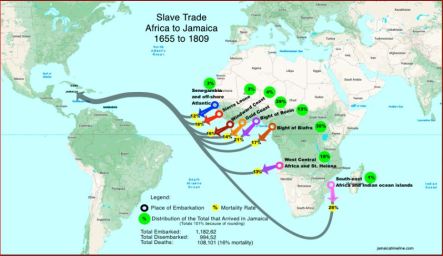British citizens owned 300,000 African slaves in Jamaica in 1831-32. The Christmas 1831 slave rebellion in Jamaica against British slave masters made it clear Emancipation was inevitable. Yet, “negotiations toward that end were protracted, in part, because of the vested interest of those in the House of Commons and the House of Lords.”…
“Slavery” and “Slave Trade” are two separate issues:
“The slave trade between Africa and the [Caribbean] West Indies was made illegal in 1807 and the traffic in slaves between the islands became illegal in 1811. However, it took another 26 years to effect the emancipation of the enslaved [from the British], when in 1833 Parliament passed the Slavery Abolition Act that finally abolished slavery in Jamaica and the other West Indian colonies on August 1, 1834.
There were many factors that influenced the legislation of 1833. There were doubts about the economic feasibility and the sustainability of slavery given the sustained resistance of the enslaved people that culminated in the major rebellion of Christmas 1831.
There was growing popular support for abolition but the negotiations toward that end were protracted, in part, because of the vested interest of those in the House of Commons and the House of Lords.
In the end, the final terms resulted in the grant of £20 million in compensation payable by the British taxpayers, 40% of Britain’s budget, to slave owners (equivalent to £2.6bn today [$3.5 billion US]).
Nothing went to the freed slaves to redress the injustices. The money went exclusively to the owners of slaves as compensation for the loss of “their property”, the slaves. The Emancipation act also introduced a system of apprenticeship that tied the newly freed people into working for low wages under their old masters or a fixed term. The intent was to “help and train” the freed slaves to be free men and women. The quotation marks are inserted because the program was not to the exclusive benefit of the slaves….
The Emancipation Act of 1st August 1834 declared all children born into slavery under the age of six, and any born after that date, free. All other enslaved persons became apprenticed to their former masters up to 1st August 1838 –– praedials (field workers) for six years and non-praedials for four years –– after which, they were to be made free. Apprentices were obliged to work on the estates for 40.5 hours per week in exchange for food, clothing, and shelter, but not wages.
The wealth created [for British owners] in Jamaica by the labor of black slaves has been estimated at £18 million (£2.3bn today [$3.1 billion US), more than half of the estimated total of £30 million for the entire British West Indies.”…
Map: 154 years of UK slave voyages from Africa to Jamaica, 1655-1809. Source: Slave Voyages Database-Trans-Atlantic Slave Trade-Estimates, via JamaicaGreatHouses.com…UK “merchants” needed 10,000 new African slaves every year for Jamaica sugar death camps. The work was so hard that a third of each new shipment of slaves died within 3 years. creating a constant demand for new slaves. “Every slave was expected to work–even women, children and the elderly….Between 1766 and 1791, the British West Indies produced over a million tons of sugar.” (BBC)
...............


No comments:
Post a Comment